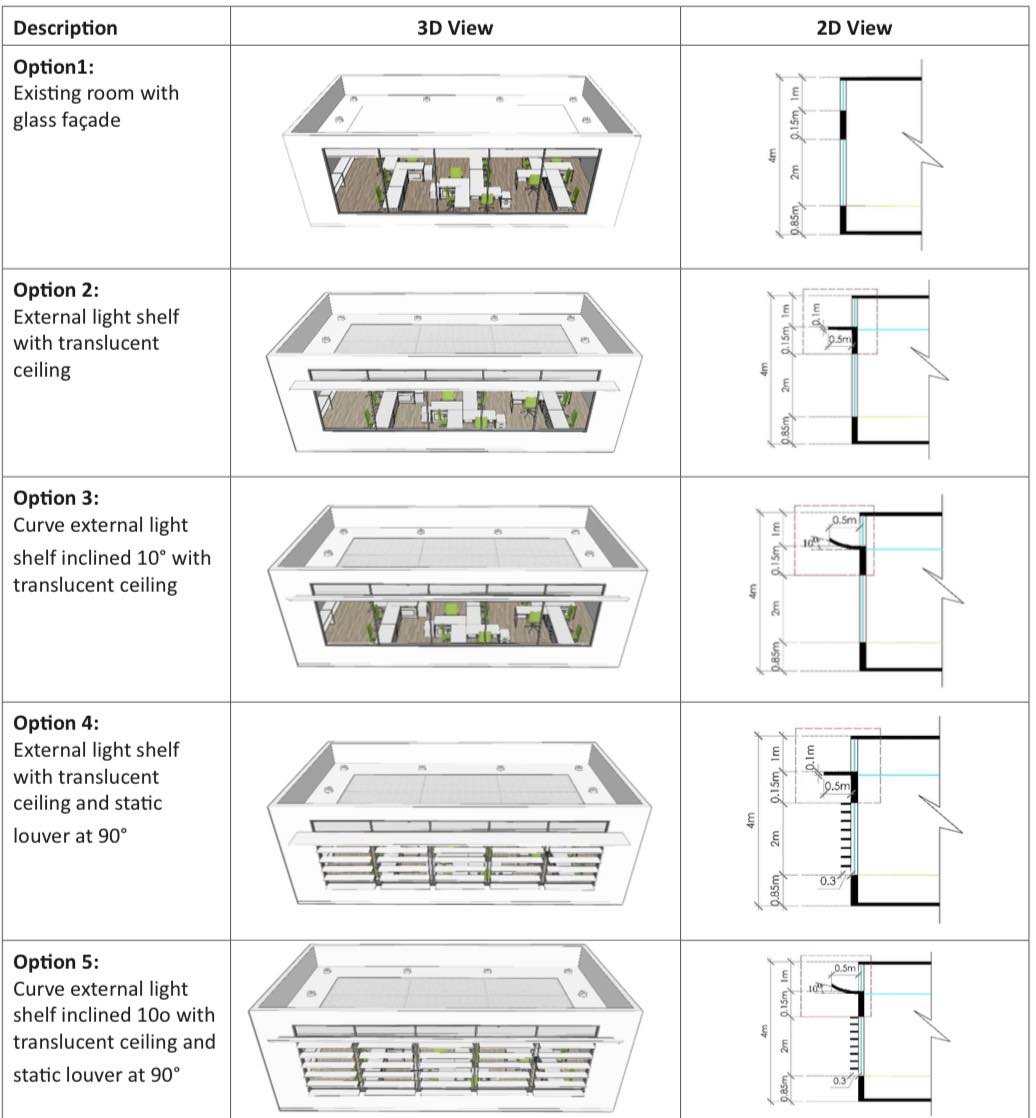The Effect of Light Shelf and Translucent Ceiling on Daylighting Performance in Office Building in Thailand
DOI:
https://doi.org/10.56261/built.v21.251701Keywords:
daylight, light shelf, translucent ceiling, illuminance, uniformityAbstract
Daylight control strategies were a challenge for a high-rise building in terms of saving energy consumption. Light shelf was one of the daylight control systems which was usually horizontal or inclined surfaces, placed on the inner and/or the outer side of windows to reflect sunlight to ceiling and distribute the light deeper into the room. This study aimed to investigate the performance of daylight control strategies in office rooms using a light-self with translucent ceiling. The light shelf, which is typically horizontal or inclined, was placed on the inner or outer side of windows to reflect sunlight and distribute it deeper into the room. The study investigated the effect of type of daylight techniques which are a combination of different light shelves and translucent ceiling on daylighting performance. The illuminance level in an office room was calculated using DIALux 4.13 and was performed for working hours in Bangkok, Thailand. The simulation was performed under clear sky conditions and using real climatic data from four orientations. Five types of daylight techniques, including the existing room, were investigated in terms of illuminance level and uniformity of daylight in the office room. The CIBSE (2015) and IESNA (2011) standards indicate that offices room should have uniformity of at least 0.8 and an illuminance level of 500 lux. Thus, the objective of this research was to determine the best combination of light shelves and translucent ceilings for achieving illuminance and uniformity standards. The results showed that the external light shelf with a translucent ceiling and static louver at 90o (option 4) was the best solution for office rooms, providing average illuminance level 776 lux (above the standard) and uniformity 0.4 (nearly the standard). This conclusion suggests that a light-shelf with a translucent ceiling guides daylight deep into the room but less uniformity.
Downloads
References
Berardi, U., & Anaraki, H. K. (2015). Analysis of the Impacts of Light Shelves on the Useful Daylight Illuminance in Office Buildings in Toronto. Energy Procedia, 78, 1793-1798. https://doi.org/10.1016/j.egypro.2015.11.310 DOI: https://doi.org/10.1016/j.egypro.2015.11.310
Brzezicki, M. (2021). An Evaluation of Useful Daylight Illuminance in an Office Room with a Light Shelf and Translucent Ceiling at 51° N. Buildings, 11(11). https://doi.org/10.3390/buildings11110494 DOI: https://doi.org/10.3390/buildings11110494
Burmaka, V., Tarasenko, M., Kozak, K., Omeiza, L. A., & Sabat, N. (2020). Effective Use of Daylight in Office Rooms. Journal of Daylighting, 7(2), 154-166. https://doi.org/10.15627/jd.2020.15 DOI: https://doi.org/10.15627/jd.2020.15
Ciampi, G., Rosato, A., Scorpio, M., & Sibilio, S. (2015). Daylighting Contribution for Energy Saving in a Historical Building. Energy Procedia, 78, 1257-1262. https://doi.org/10.1016/j.egypro.2015.11.270 DOI: https://doi.org/10.1016/j.egypro.2015.11.270
Issarasak, S. (2020). . Research Gate.
Kontadakis, A., Tsangrassoulis, A., Doulos, L., & Zerefos, S. (2017). A Review of Light Shelf Designs for Daylit Environments. Sustainability, 10(2). https://doi.org/10.3390/su10010071 DOI: https://doi.org/10.3390/su10010071
Lee, H., Seo, J., & Choi, C.-h. (2019). Preliminary Study on the Performance Evaluation of a Light Shelf Based on Reflector Curvature. Energies, 12(22). https://doi.org/10.3390/en12224295 DOI: https://doi.org/10.3390/en12224295
Mesloub, A., Ghosh, A., Albaqawy, G. A., Noaime, E., Alsolami, B. M., & Zhao, D. (2020). Energy and Daylighting Evaluation of Integrated Semitransparent Photovoltaic Windows with Internal Light Shelves in Open-Office Buildings. Advances in Civil Engineering, 2020, 1-21. https://doi.org/10.1155/2020/8867558 DOI: https://doi.org/10.1155/2020/8867558
Sern, C. H. Y., Liou, L. T. K., & Fadzil, S. F. S. (2022). Daylighting Performance of Integrated Light Shelf with Horizontal Light Pipe System for Deep Plan High-Rise Office in Tropical Climate. Journal of Daylighting, 9(1), 83-96. https://doi.org/10.15627/jd.2022.6 DOI: https://doi.org/10.15627/jd.2022.6
Sok, T. (2018). A Study of the Effect of Characteristic of Multiple Curve Light Shelf on Daylighting in University Classroom [Master of Architecture (Building Innovation), Kasetsart University]. Thailand.

Downloads
Published
How to Cite
Issue
Section
License
Copyright (c) 2023 International Journal of Building, Urban, Interior and Landscape Technology (BUILT)

This work is licensed under a Creative Commons Attribution-NonCommercial-NoDerivatives 4.0 International License.











